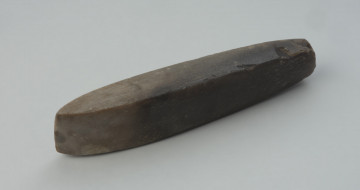
Flint chisel
National Museum in Szczecin
Part of the collection: Stone Age
A flint axe found its way to the Szczecin Museum collection in 1913. It was donated by Hans Lenz, the owner of an estate and palace in Stolec (German: Stolzenburg) built in the first half of the 18th century. He was a son of a Pomeranian entrepreneur, pioneer and tycoon in the sector of regional narrow-gauge railways in Germany and German colonies, a councillor of Szczecin, secret councillor Friedrich Lenz (1846-1930), who was a friend of Hugo Lemck, a professor of grammar schools and the president of the Society for History and Antiquities of Pomerania (Gesellschaft für Pommersche Geschichte und Altertumskunde). The artefact was donated to the Society's collection of Pomeranian antiquities along with several other finds from the Stone Age: an ornate dagger made of reindeer metatarsal bone and a stone axe, and two other flint axes. All these objects were discovered under fieldstones collected in a mound. The circumstances of their finding and their varied chronology, from the end of the Old Stone Age to the Late Neolithic phase, suggest that these artefacts did not initially form an assemblage but instead were removed like the stones from the field to one place during agricultural work. The axe from Stolec is characterised by its trapezoidal shape, narrow shank and lenticular cross-section. In terms of the manner of their execution and form, it refers to double-walled specimens with a sharp-oval cross-section and a pointed hilt, widespread in the younger Stone Age in the northern (Nordic) areas. Their different varieties, associated with the Middle or Late Neolithic, also appear in Central and Western Europe. In the first decades of the 20th century, they were described as "Viervitz-type axes", after the name of a village on the island Rügen. Several tens of finds of this type of flint artefacts come from Pomerania and Mecklenburg, usually discovered without a context that would allow a link to a specific archaeological culture.
Krzysztof Kowalski
Author / creator
Dimensions
cały obiekt: height: 8.8 mm, width: 3.8 mm
Object type
axe
Technique
smoothing, carving, hand made
Material
flint, stone
Origin / acquisition method
acquisition
Creation / finding place
Owner
National Museum in Szczecin
Identification number
Location / status